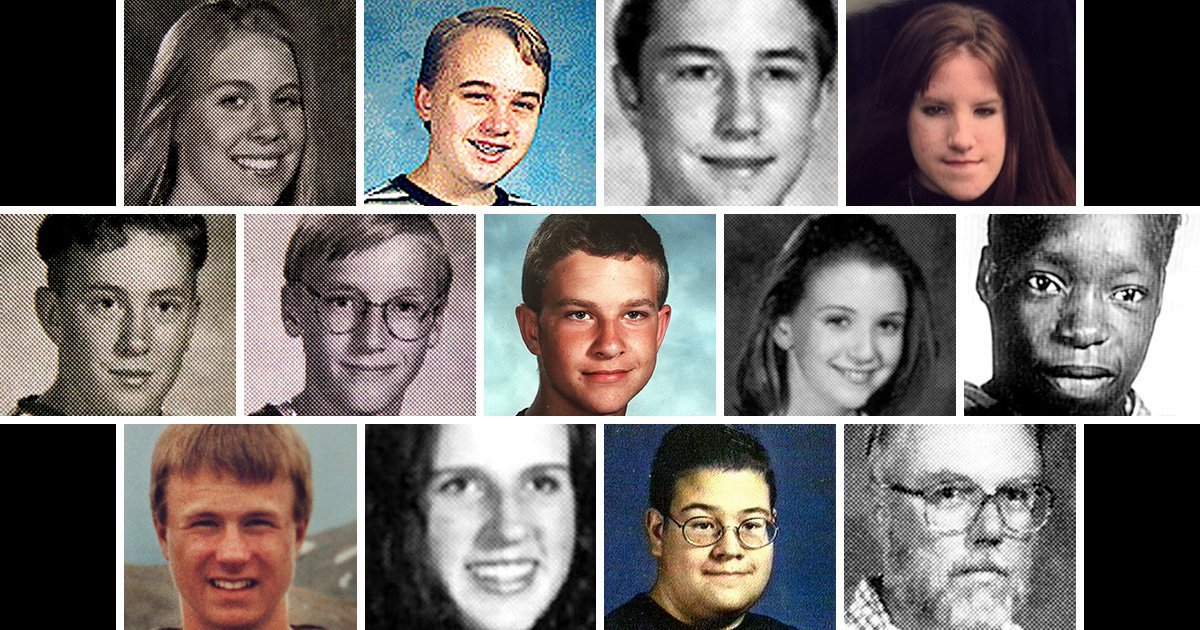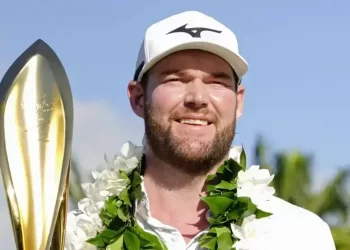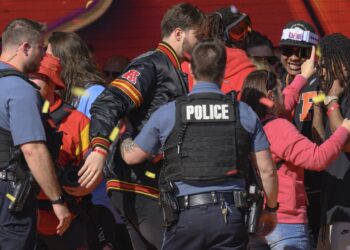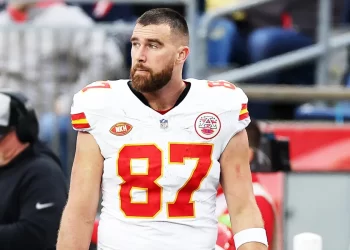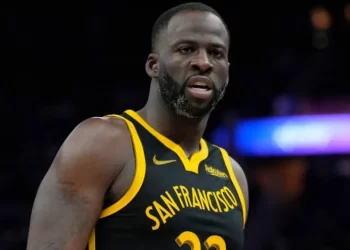It was just a normal day on Tuesday, April 20, 1999, at Columbine High School in Littleton, Colorado.
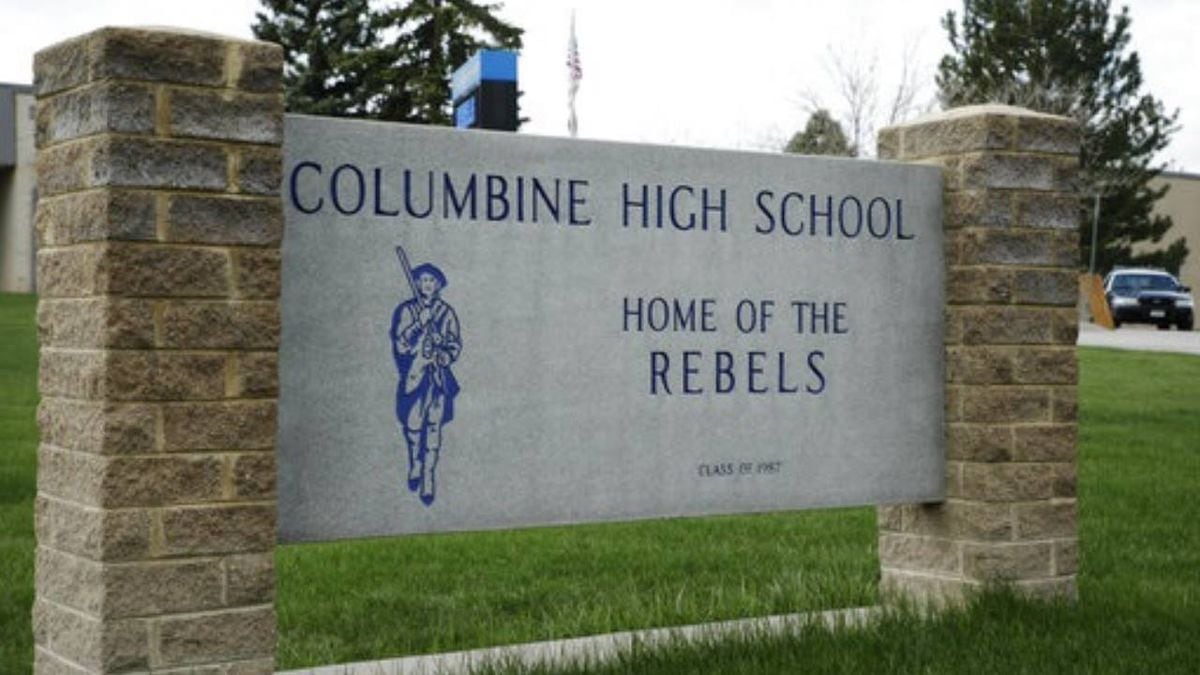
(Courtesy: WSBTV)
Students and teachers were going about their business going from class to class, mingling with friends and colleagues, navigating through the halls, and for many, it was their favorite period; lunchtime.
All of a sudden loud popping sounds were radiating through the school.
Two male students wearing long black trench coats and armed to the teeth with high capacity weapons and homemade bombs went on a rampage that left 12 students and 1 teacher dead while 24 others were wounded.
In the end, the two shooters took their own lives. At the time, it was the deadliest school shooting in American history and it unleashed a nationwide conversation on the issue of violence in schools and among young people.
Twenty years later the conversation on gun safety and school violence continues. Many have worked tirelessly to try to figure out what could have driven two young men to commit such as horrific and deadly acts against their school and peers. Many factors contributed to the carnage, but this is a time to reflect on certain particular examples that people are discussing more than twenty years later.
One cannot talk about Columbine without going into the epidemic of gun violence and how mass shootings are at this point all too common.
One cannot talk about Columbine without talking about how our society and culture define manhood and masculinity. After all, the majority of the shooters are men.
Finally, one cannot talk about Columbine without looking into what sports can do to be part of the solution.
When looking at these components and how they intersect with one another we can finally learn the lessons from Columbine and prevent such acts of violence. There is potential for athletes, coaches, athletic directors, and sports social workers/psychologists to take the lead and play a major part in changes that are greatly needed in our society today.
Gun Violence:
We must reckon with the fact that we live in a country where gun violence has run amok and we embrace a toxic gun culture that obsesses over guns and seemingly loves them.
We see it all over in our government, our streets, our towns, our popular culture, our schools, our communities, and among our families.
Over 30,000 Americans die from gun violence every year and over one million have been killed since 1968 when Dr. Martin Luther King Jr. and Robert Kennedy were gunned down by assassins’ bullets.
Gun violence has a ripple effect on every aspect of our lives and is one of the greatest public health emergencies we face right now, even if our elected leaders will not call it as such. The world of sports is not immune to it.
Athletes and Guns:
Now it is important and a must to keep in mind that athletes are no more likely to be engaged in gun violence that the general population.
However, that does not mean that there isn’t room for a discussion about guns in the sports world and figuring out ways in which athletes and others around them can use their platforms to speak out.
While the aftermath of Columbine didn’t produce much reaction from the broader sports community, there was a greater reaction after the Parkland shooting in 2018 from stars like LeBron James, Dwayne Wade, and Carmelo Anthony.
NBA legend and civil rights icon, Bill Russell, expressed support for the March for Our Lives organized by the Parkland students.

(Courtesy: Wikipedia)
At that same time, former NBA legend Steve Nash wrote an amazing article in The Player’s Tribune entitled “We Are In This Together” https://www.theplayerstribune.com/en-us/articles/steve-nash-gun-violence discussing the urgency to combat gun violence.
In the aftermath of the Thousand Oaks Shooting in California, LeBron and the Los Angeles Lakers along with the Atlanta Hawks, Milwaukee Bucks, and Los Angeles Clippers wore t-shirts honoring the victims and on the front, it read “ENOUGH”.

(Courtesy: Orange County Register)
In the past, it was Lebron, DWade, Chris Bosh, and the rest of the Miami Heat that all donned hoodies in solidarity with Trayvon Martin and his family in 2012 after he was murdered in cold blood by a wannabe neighborhood watchman because he was a young black man in America.
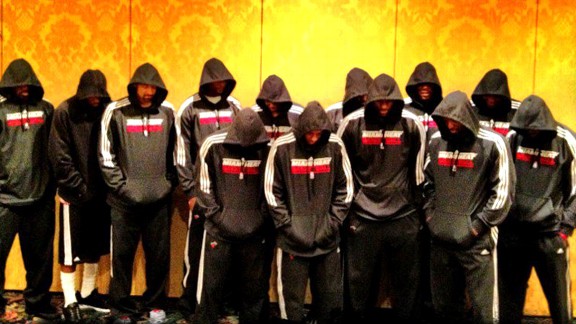
(Courtesy: ESPN.com)
Also, who could forget at the 2016 ESPY awards where LeBron, DWade, Carmelo, and Chris Paul took the stage in the aftermath of the police killings of Alton Sterling and Philando Castile as well as five police officers in Dallas who were gunned down and demanded a call to action on issues such as gun violence from athletes.

(Courtesy: USA Today)
That same message was echoed by members of the Minnesota Linx and New York Liberty of the WNBA who wore black t-shirts in solidarity with Black Lives Matter and the Dallas officers.
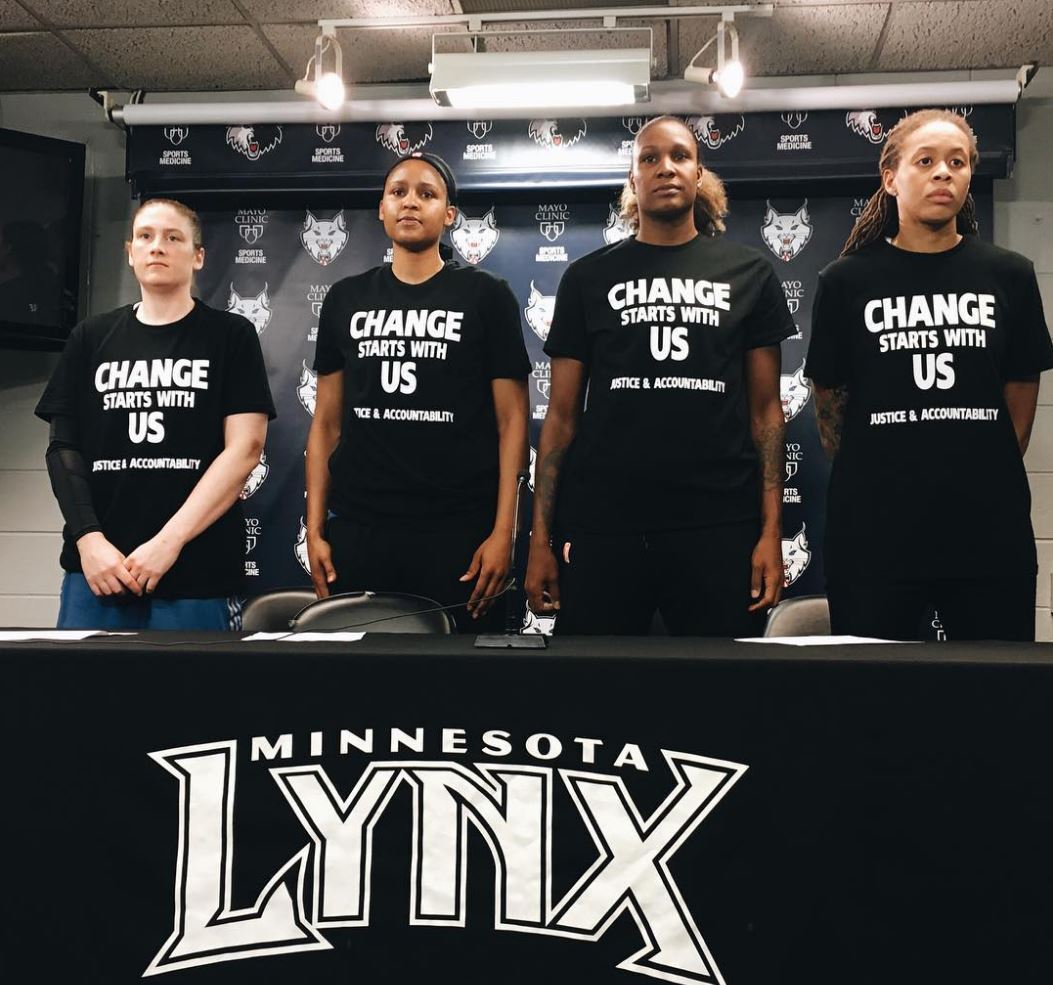
(Courtesy: cbsnews.com)

(Courtesy: colorlines.com)
There is a more concerted effort on the part of athletes to do more since Columbine in 1999 and part of that includes the increased accessibility of athletes and the ability to control the narrative on one’s terms through social media. It is important to keep in mind that this discussion goes beyond just the issue of guns and their easy availability but to a much larger cultural narrative.
What was lost in the media coverage and the subsequent efforts on the part of so-called experts in their analysis of Columbine was they left out a very critical aspect that led to the shooting and that was gender, particularly how we define manhood.
Toxic Masculinity:
Masculinity is historically rooted in patriarchy, a system built on domination, exploitation, and hierarchy. In other words, in the eyes of this institution, men are seen as superior to women and a certain male prototype is embraced.
The only acceptable example of manhood is someone who is tough, strong, aggressive, dominant, controlling, and doesn’t show any signs of weakness or vulnerability. The alpha male, the stoic male cultural icon such as John Wayne or the Marlboro Man, the playa, the mack, the protector, the provider, etc. are the male paradigms that our culture holds up as ideal images of what men and boys are supposed to live up to.
A man who doesn’t fit any of these and may identify as LGBTQ, gender-non conforming, non-binary, advocates for gender equality, or maybe into the arts or computers are usually cast aside and seen as “sissy”, “weak”, “soft”, or worse.
In the halls of Columbine High School, the two shooters didn’t live up to the traditional examples of manhood and were ridiculed for it.
They felt disrespected and in male culture, respect is a must. As Omar Epps said to Tupac Shakur in the coming of age film Juice “if you want respect you got to earn it!” So, if respect is not given, it has to be achieved at any cost, including violence.
That notion of manhood has led to men and boys engaging in risky and at times violent behavior in order to assert one’s manhood and men are reluctant to seek out help for depression or anxiety because men are not supposed to talk about their problems in the ways that women do.
That comes at a cost in terms of our lives and the lives of others. If we bring this conversation back to guns for a moment, the overwhelming majority of perpetrators of gun violence are men and most of them have a history of domestic violence and/or misogyny.
Or we can look at male athletes killing themselves with guns such as Tyler Helinski, Kenny McKinney, O.J. Murdock, Ricky Berry, Alexis Arguello, and Junior Seau.
Or we can even look at how coaches have reignited toxic masculinity through their dictatorial coaching styles to where their male athletes are not to show pain or be vulnerable.
Bear Bryant, Bobby Knight, Woody Hayes, Bo Schembechler, Mike Gundy, Mike Rice, D.J. Durkin to name a few have embraced this General Patton style of coaching that embraces those patriarchal beliefs and create an atmosphere of walking on eggshells where one slip up means that the coach is given the authority to degrade and dehumanize.
This is not the type of example of manhood that men and boys should aspire to be because simply there is something almost pathological about taking joy in making someone feel less than. That is why this is the time to offer alternatives.
Jock Culture:
Much of the commentary in the aftermath of Columbine focused on the jock culture in which the athletes seemingly ruled over all the students.
They were supposedly granted special privileges from teachers and administrators and were able to get away with acts of bullying and harassment towards other students who didn’t fit their clique, including the two shooters.
The jocks often wore white baseball caps to school to signify their allegiance. The narrative was that the shooters singled out the jocks in the rampage as an act of revenge.
The reality was much different as every student was a target and there were athletes who countered those descriptions.
It is important to understand that the jocks are not to blame, nor is anyone else to blame for the massacre at Columbine except for the two shooters.
It is crucial to remember that three student-athletes and a popular coach died that Tuesday morning. Isiah Scholes and Matthew Ketcher were celebrated members of the football team and Lauren Townsend was the class valedictorian and on the Volleyball team.
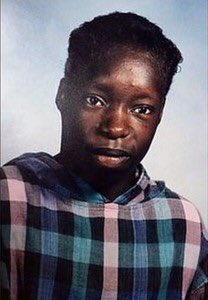



(Courtesy: Twitter, Denver Post)
All three died in the library that day.
Coach Dave Sanders was very well-liked by the students and faculty and coached many teams. He died as he was trying to evacuate students out of the building.
He was awarded at the 2000 ESPY’s with the Arthur Ashe Courage Award.

(Courtesy: Youtube)
What Athletes Can Do:
If there is anything that can be taken away from that day as it pertains to student-athletes is for them to be part of their school beyond the field and court.
Programs and initiatives should be set up to where student-athletes can give back to their school and to their communities in the form of community service, raising awareness for different causes at games, and partnering with local organizations.
Going Forward:
It is hard to believe that it has been 21 years since Columbine and it is sickening that these issues are still being addressed after all this time.
It is easier to imagine the literal end of the world than the end of gun violence.
Hopefully, we can take some pause to reflect where we were then and where we are now and how there is more potential than ever to actually tackle this head-on.
We have more resources to work with than what was available in 1999.
We have the resurgence of a new movement to combat gun violence led by the young people in Parkland, Florida and elsewhere.
We have more talking about toxic masculinity than ever before and the American Psychological Association has published recommendations to work with men and boys in different settings as well as popular commercials such as the more recent one by Gillette that permits us to engage.
We also have a new era of athletes wanting to do more than simply do well athletically, but to actually use their platforms to articulate their vision of a better America and a better world. If you put these efforts together, we have something magnificent to work with.
We need to take advantage of these opportunities.
We can do justice to those in Littleton and elsewhere.
Now is the time. It is in our hands. We are the rebels with a cause.

(Courtesy: Wikipedia)


 NFL
NFL